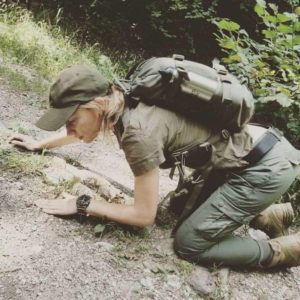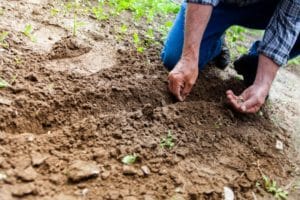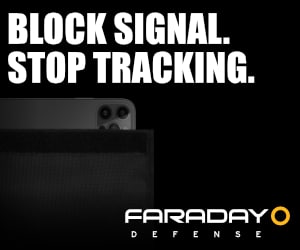In the first article, “Reconquering the art of Tracking Men and Animals“, we actually started our journey into discovering an ancient, fascinating skill that still alive nowadays. We went over the background and the current applications of reading and interpreting tracks. These techniques were useful for tracking human being and animals.
Now it’s time to look into more detail about tracking, and remember: anyone can learn how to track and make it become part of their skillset.

As stressed in the first article, the fundamentals of the Art (often called also “Science”) of Tracking involves the accurate observation of what surrounds us.
A meticulous examination of the whole area is important, Even details like what time of day it is are important.
These details make up our data and there are several factors to consider:
- the type of soil we are stepping on – craggy, sandy, grassland…
- the kind of terrain – slopes or flat ground.
- the season and the weather conditions (also considering the recent ones)
- the presence (or absence) of other individuals and/or animals or vehicles
- the presence (or absence) of civilization – towns, villages, etc.
Our senses can capture great information, pay special attention to:
⁃ noises (animal calls, people voices, vehicle sounds and so on)
⁃ smells (for example, wild animals usually give away a very sharp odor, especially carcasses: think for example of skunks, mostly easy to recognize!)
Last but not least, we use also the sense of touch in order to determine if something we are analyzing is actually smooth or sharp, consumed or fresh.

If all the above mentioned elements sound straightforward, don’t be surprised: Tracking is mostly based on common sense and allowing ourselves to reexamine the way we take in our surroundings. For this specific purpose, Trackers are not necessarily a special breed of person, as wisely said by AB Taylor in his great manual: “Fundamentals of Man Tracking: The Step-by-Step Method: An Essential Primer for Search and Rescue Trackers” (2014): (trackers) are acclimated to in-depth, daily investigation. In few words, Trackers are like… detectives. And the character of Sherlock Holmes is something that immediately comes in mind every time you think of tracing footsteps, right?
That said, in each single act of reading tracks, we must consider two distinctive metrics:
The lower level is identified by the mere ground. The upper level consists in soil that is pushed up. For this specific reason we distinguish two types of tracks: ground spoors and aerial spoors.
In order to become proficient trackers, we need to apply our focus on both of them, and confirm the first with the seconds and vice versa.
As a matter of fact, a track line in an area full of vegetation, for instance, offers us the true chance to examine the tracks in low signs as well as broken or just damaged upper vegetation.

In soil, there are several disturbances to take note of:
⁃ the entire outline of a track (if you are lucky enough to have sandy or muddy soil, known as “track traps” which allow you to see a footprint or animal’ hoofs and paws)
⁃ small signs like dislodged pebbles, broken twigs, bent leaves, flattened grass leaves, transfer of material like mud, snow, sand or any liquid material, even pile-up of dry leaves, pine needles and so on
In the same way, upper vegetation, as mentioned, can be disrupted by the higher part of the body of an animal and/or a person: in this case, we can observe twigs broken or bent, leaves which show their upside, downside, as well as scratches, fibers or even hair trapped in it.
Confirming aerial spoors with ground spoors happens to be one of the most important rules of the art of tracking: you cannot put your eyes on the ground and just forget controlling and analyzing what lays up to your feet. You must also consider the fact that often aerial spoors are visible and they represent a helping hand to the tracker involved in tracing a track line!
Once you’ve learned the habit of being accurate in your observation skill, you can proceed into perfecting the rhythm of your movements according to the specific scenario. If you don’t want to miss any aspect, you need to slow down and never jump to conclusions. Assumptions and Personal Ego are indeed the worst enemies to a Tracker.
So, I strongly recommend starting with easy terrain, like the already mentioned “Track Traps”. If you can find a good area in which you can see clearly tracks, then you can start learning your first techniques in this art and also learn how you can interpret the track line you are looking at.
Speaking of human footprints, on easy ground. Soft ground is very useful for collecting information you can’t get elsewhere:
⁃ The size of a given track (measurable from the heel to the toe). It reveals if the subject is male or a woman, but don’t make assumptions: I once met a girl who wore a size 8!
⁃ The type of pattern the person was wearing (flat shoes, classic or boots). No doubt it can tell us if the person was wearing the appropriate type of shoes for a hike. If not, this should put us on alert.
⁃ The stride – the distance the heel to heel of a set of tracks – right and left and vice versa – or from to toe to toe or, again, from heel to toe. This measurement can allow us to understand if the person was walking, running, the approximate age – elderly people have a shorter stride – or if he/she was carrying a load.
⁃ The straddle – the distance between the two tracks taken from the middle axis of each one. Often underrated, this assessment can report any flaw in deambulation, which can be due to a wound, any inborn deformity or any heavy freight.
In addition to that, a Track Trap terrain can clearly indicate to us the direction of travel, and if the person we are tracking was passing through an area alone or along with other individuals.
Last but not least, the over-impression of other tracks, as well as a sudden change of weather conditions, or the transition of wildlife let us identify the time frame in which the tracks have been left, as we will see more deeply in the next articles.
We will talk also about the light angle – a valuable factor to consider once you are on a determined Trackline.
I can’t stress enough the fact that only experience can turn you into a proficient tracker. The successful application of your skills will enable you not only to track properly men or animals but will also allow you to gain a more conscious level of situational awareness, turning you into a more focused individual in each one of your daily activities.

















